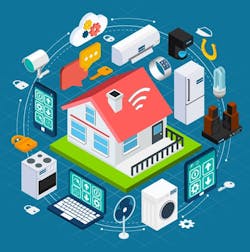At the Eliot program launch in the Big Apple, Legrand insiders reveal how collaboration can advance the IoT in smart buildings.
Known for its electrical infrastructure business, Legrand has expanded its operations to include digital building technologies including wireless controls, smart lighting, and building automation products. Recently, Legrand USA marched out a program to partner with some of the biggest Internet of Things (IoT) technology players, demonstrating its view of the smart play into smart tech: collaboration among controls, lighting, mobile device, and IT/applications developers to leverage their strengths and build interoperability into all of the “things” in the IoT. (For partners, think Samsung, Amazon, and Cisco – key innovators in connected and intelligent products and services.)
The Eliot (Electricity and IoT) program centers around a purpose-built cloud and communications gateways that will enable interoperability of devices from various providers to enhance experiences in both smart homes and commercial smart buildings. At New York City’s Lightbox venue on Nov. 10, Legrand North and Central America CEO John Selldorff and CMO Stephen Schoffstall presented the program and delivered highlights on Legrand’s IoT partners. LEDs Magazine was able to speak with Tom Lowery, president, and Jim Young, vice president of marketing, Building Controls Systems division, to explain the implications of Eliot and discuss the company’s lighting controls business vision.
Interested in articles & announcements on smart lighting & IoT?
LEDs Magazine: Does the Eliot brand imply anything in terms of the type of network connectivity or protocols used in a product, or does it more simply just imply that connectivity is in play? When Eliot was initially presented, a connected lighting switch was presented as an example product and was based on the 6LoWPAN network and the Thread software stack. But it seems other products associated with Eliot use different mixes of connectivity, networks, and protocols.
LEDs: So Eliot is more about branding the partnerships and the interoperability of products and services versus “we are rolling out a product and it is going to have the Eliot brand on it”?
TL: Exactly. It is an IoT program versus a product line.
LEDs: On the top-level page of the Eliot section of your website, the Digital Lighting Management (DLM) portfolio of products is listed as part of Eliot. But on the Eliot In Action section of the site, lighting is not listed as one of the key opportunities or applications for Eliot. Emergency lighting is specifically identified, but general lighting is not. How important is the general lighting market for Legrand and what are the IoT plans in that sector? I noticed that you have acquired Pinnacle Lighting, so how does that fit in?
TL: First of all, if you look at Internet of Things; that’s end devices that have “smarts” and sensing capability and data, and those are all on the either local network or can go to a network externally. So if you think about DLM, our Digital Lighting Management system, we have sensing in the room… Now what’s happening in the general lighting market is we’re getting more and more sensing technology and intelligence in the fixture itself. So you can think of a Pinnacle fixture that has a DLM sensor in there, that could [be] sensing occupancy; it could have a temperature sensor in there; and so the lighting fixture itself starts to become an endpoint of the IoT infrastructure.
LEDs: You said something key that I was looking for during the preparation for this event, in terms of Legrand’s viewpoint and where [the company] is working on IoT. Is [Legrand] working under the assumption that the light fixture is going to become a hub or a node for the entire building services/systems that are being offered?
TL: If you think about it, if you look at this room, there’s more endpoints with the lighting fixture[s], and you think about all of those in an office, how many different points of sensing could you have in an office building if every fixture had a sensor on it? You could know occupancy traffic and so forth. So it really becomes an endpoint.
Jim Young: To take that further — so, just by the nature of providing light, you’ve got digital controls that are present in the lighting fixture. Just like providing power, you’ve got a receptacle and a switch, so when we talk about Eliot working within a building, we see it really as about exploiting those places you have to have power, and then we’re mostly in the commercial part of it; but you can move it into healthcare, education, even the home environment. Those parts or those points in the room are ubiquitous. So it’s not an issue of finding a spot — you’ve already got a spot. You have to have a light to provide the task just like you have to have a place for power. It provides a natural location, if you will, and so more likely than not, you’ll see the intelligence move from outside of those places and really locate in the device. It’s really about location.LEDs: So are any of the Pinnacle offerings actually going to be doing that? Are they going to be integrated with controls, or are they already integrated?
JY: Yes, they already integrate, I would say, from a basic way — meaning that it’s a basic sensor and motion detection provided, sometimes daylighting. So we’re already at that tipping point that we’re starting to see more of a digital control system approach versus sort of a standalone analog type sensor that’s just [delivering] one function. Where now the controls that are in the fixtures are talking to one another. So that is just really starting to happen.
LEDs: In the presentation, John mentioned human-centric lighting. What is Legrand working on now, or what does the company see as the opportunity to deliver that kind of lighting?
JY: The color variable — that’s what we call it — it’s really a control variable. You used to have just up, down — now you’ve got up, down, and you’ve got color. What they’re gonna tell you is, “I’m excited about what I can do with that, but now how do I control it?” So the missing part is how you control it both as a user in the space but then also from a designer/specifier standpoint… I have a goal of having this color temperature in this space; how do I make that happen? And ensure that it happens for my client? So that’s why we’re excited about the combination of Lumenetix and DLM, because Lumenetix provides a way to control the LEDs; Wattstopper DLM will allow you do the control function. We look at it as, it’s like a color variable is now in our space.
LEDs: It’s coming down to learning more about color science, and promoting that. That’s one of the things we have been talking about, and hearing from others in the industry. Tunable white, yes, a lot, and tunable color, to a point. I think a lot of people have been saying with tunable color, “Well, that’s nice, we can create some pretty colored lighting effects,” but really it comes down to what you are doing with it. It’s not just then about entertainment, but how are you using it to enhance the space and how is the lighting serving that purpose.
JY: If you think about it, all of our specifiers and then us in our homes — we have to make a decision on color temperature. Whether we specify or purchase a lamp or a fixture, we have to decide what’s the color temperature. And with LED, it’s a little different, especially in a commercial environment because we don’t have the option of replacing the lamp — there is no lamp anymore! It’s an integrated fixture. So one of the opportunities that we see — let’s move human-centric lighting over here for a second — let’s just say we want better lighting, quality lighting. So the ability for the specifiers to choose a light fixture that’s got a Wattstopper or Lumenetix technology in it, let’s take it out to the space…this room may be used as a lab, this room might be used as a training room… I can adjust to the optimal color temperature in each space from the same fixture. I think that’s the dynamic where we see it as being — I don’t want to say relevant but more important initially with tunable white, is just [that] it simplifies your decision making about color temperature. Because you have the flexibility of changing that from the fixture and delivering the color temperature.
LEDs: You’re not constrained by buying a fixture that has tunable capability that’s built into it but it only has or covers a certain spectrum. You can select different qualities that you want in the lighting [when you add it into a digital system].
JY: Yeah, like if you buy a lamp at the store, you’re making a decision, well, I want that color. But if you don’t like that, you have to replace the lamp. In a commercial environment or an education environment, the ability to modify, to say based on what’s going on with the windows, what type of space it is… “I think I want to go a little warmer, or I want to go a little cooler,” and not have to buy a new fixture and replace a fixture, that’s where we start to see it become very interesting because [we] talked about shading — so shading to reduce glare affects the light. And maybe you want a different color temperature when the shades are down, versus when they’re up. But now you can do it! You couldn’t do it before. You had to swap it out and buy something new. Now you can do it with the existing system.







